

We the people - using the power of citizen science: Michelle Anne Luebke at TEDxJerseyCity. Sonoluminescence - Cavitation - NanoGeometry & The Future of Technology (See Vid Description) Channel One News. Animal Adaptations. Science Videos. The Super-Resolution Revolution. New Simulation Re-Spins the Cosmic Web More Accurately. Comics (funny comics & strips, cartoons) Hands-on Activities for Teaching Biology to High School or Middle School Students.
By Drs.
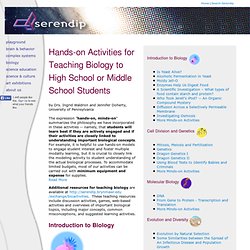
Ingrid Waldron and Jennifer Doherty, University of Pennsylvania The expression "hands-on, minds-on" summarizes the philosophy we have incorporated in these activities -- namely, that students will learn best if they are actively engaged and if their activities are closely linked to understanding important biological concepts. For example, it is helpful to use hands-on models to engage student interest and foster multiple modality learning, but it is crucial to closely link the modeling activity to student understanding of the actual biological processes. More Minds-on Activities for Teaching Biology. The resources listed below include: minds-on, hands-on activities and minds-on analysis and discussion activities for teaching biology to high school and middle school students and students in non-major college biology coursesoverviews of important biological topicsgames for learning and review.

Many of these activities are explicitly aligned with the Next Generation Science Standards, as indicated by (NGSS) in the descriptions below and as described in Summary Tables and in the Teacher Notes for individual activities. These activities foster student understanding of Disciplinary Core Ideas, engage students in Scientific Practices, provide the opportunity to discuss Crosscutting Concepts, and prepare students to meet the Performance Expectations of the Next Generation Science Standards. We encourage you to subscribe to our listserv to receive notices when we post new activities or significantly improved versions of current activities.
Home of CELLS alive! Frequency Light. The Physics Front. Vibration Creates Matter. #eTHErSEC. Enhanced virtual microscopy for collaborative education. Computational Visualization of 4D Cardiac Flow. Carolina Curriculum: Games > CellCraft: Exploring the Cell Through Gaming. Understanding Art and Science with @ArthurIMiller. – December 22, 2014Posted in: Episodes Arthur Miller According to our guest, Einstein thought like an artist, and Picasso thought like a scientist.
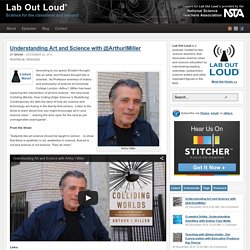
As Professor emeritus of history and philosophy of science at University College London, Arthur I. Www.glencoe.com/sites/common_assets/science/workbooks/tennessee/7tcap2.pdf. Paper Folding to the Moon. Note: This post has been updated and improved for 2014 here, at the new Starts With A Bang blog.

What follows below is the original version from 2009. Okay, as many of you had heard, I’ve got a new job as a full-time Professor. Rocks and Minerals by Sy Su on Prezi. Rocks & Minerals. Mind of Plants : Documentary on The Intelligence of Plants. 2014-09-29 Food Hub. The Colors of Infinity - Abysimus. The secret life of volcanoes: using muon radiography. By Paolo Strolin A new imaging technology The really important advantages of muon radiography of volcanoes are two-fold.

First, whereas current indirect methods can provide information to a spatial resolution of some 100 m, muon radiography can be up to ten times more specific, mapping internal structures to a resolution of some 10 m. Messier Monday: Andromeda, the Object that Opened Up the Universe, M31. “We find them smaller and fainter, in constantly increasing numbers, and we know that we are reaching into space, farther and farther, until, with the faintest nebulae that can be detected with the greatest telescopes, we arrive at the frontier of the known universe.”

-Edwin Powell Hubble With 110 deep-sky objects scattered throughout the heavens, the Messier Catalogue provides skywatchers across the globe with a number of spectacular targets, from nearby nebulae and clusters to spectacular, distant galaxies. Each Monday, we spotlight a new one right here. Image credit: Rolando Ligustri, taken over many years, retrieved from But there’s only one Messier object that can lay claim to literally having changed our picture of the entire Universe. The Diversity of Coolia spp. (Dinophyceae Ostreopsidaceae) in the Central Great Barrier Reef Region.
Background Dinoflagellates are important primary producers, crucial in marine food webs.
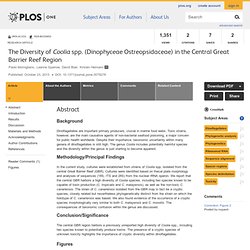
Toxic strains, however, are the main causative agents of non-bacterial seafood poisoning, a major concern for public health worldwide. Despite their importance, taxonomic uncertainty within many genera of dinoflagellates is still high. The genus Coolia includes potentially harmful species and the diversity within the genus is just starting to become apparent. Cool Videos: Diving for Drugs. Who says biomedical scientists always have to work indoors?
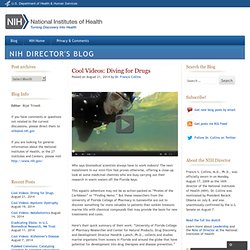
The next installment in our mini-film fest proves otherwise, offering a close-up look at some medicinal chemists who are busy carrying out their research in warm waters off the Florida Keys. This aquatic adventure may not be as action-packed as “Pirates of the Caribbean” or “Finding Nemo.” But these researchers from the University of Florida College of Pharmacy in Gainesville are out to discover something far more valuable to patients than sunken treasure: marine life with chemical compounds that may provide the basis for new treatments and cures. Some Cells Know How to Keep Their Secrets. The Periodic Table of Elements. The Sea - Discover Ocean Life and Reef Aquariums on Sea and Sky. Imagine If Every School Played *This* Video Before Class. Wisdom comes with age, huh?

Don't try telling that to Kid President. The kid's on fire in this insightful and funny pep talk that we can all most definitely take something from. Kid President doesn't claim to know it all, but he does know a few things. This magical button delivers Upworthy stories to you on Facebook: And I tell you what, if you wake up in the morning with at least one of these five things on your mind, I bet you'll conquer your day. 1. We are all unique and weird and amazing in our own ways. It's science, man!
2. Be nice instead. Get Curious. Tyler DeWitt: Hey science teachers. Christopher Emdin: Hip-Hop and the Remix of Science Education. Wp-content/uploads/2013/03/Bowser_Hansen_Preece.pdf. Solve Puzzles for Science. Biotracker.byu.edu/#home. Mariette DiChristina: "Science Is an Engine of Human Prosperity" On Thursday, July 17, four science experts served as witnesses at the U.S.
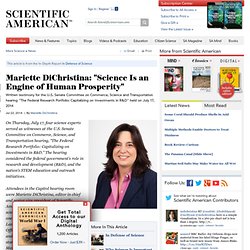
Ching science as a language: A “content-first” approach to science teaching - Brown - 2008 - Journal of Research in Science Teaching. The Biology Corner. The Life, Times, and Accomplishments of Antony van Leeuwenhoek. Fabien Cousteau Leads "Aquanauts" in Record-Breaking Undersea Expedition. Fabien Cousteau is leading a team of scientists, educators, and filmmakers this month on the longest-ever expedition in a stationary habitat beneath the sea. The project, called Mission 31, aims to build awareness about the need to protect the ocean and honors a historic expedition 50 years ago by Cousteau's famous grandfather, explorer Jacques Cousteau. Launched on June 1, Mission 31 is a 31-day, privately funded expedition at Florida International University's Medina Aquarius Reef Base.
The habitat lies 63 feet (19 meters) below the surface in the Florida Keys National Marine Sanctuary. Windows look out on swimming fish and deep coral reefs. (See "Stunning Underwater Photos for World Ocean Day. ") Random Group Creator. Renaissance Alchemy and the Scientific Method. Few scientific disciplines defined the complexity of the Renaissance as much as alchemy, an area where philosophy, science, occultism and theology came together. Lead to Gold, Sorcery to Science: Alchemy and the Foundations of Modern Chemistry.
Mention the word ‘alchemy’ and certain images spring to mind: the lone sorcerer-scholar poring over ancient manuscripts and combining bubbling flasks by flickering candlelight. Biochemistry for Medics – Lecture Notes. Hemoglobin, a chromo protein, found exclusively in red blood cells is actually a conjugated protein containing heme as prosthetic group and globin as the protein part apoprotein. The normal concentration of Hb in an adult varies from 14.0 to 16.0 gm%. Approximately 90 mg/kg of Hb is produced and destroyed in the body every day. Hb has a molecular weight of about 67,000. Bacterial Cell-to-Cell Signaling in the Gastrointestinal Tract. Fern Spores - Extended Version. Proceedings of the National Academy of Sciences of the United States of America, Vol. 30, No. 7 (Jul. 15, 1944), pp. 155-161. Flume & Chet Faker - Drop the Game.
ATP Synthase: The power plant of the cell.